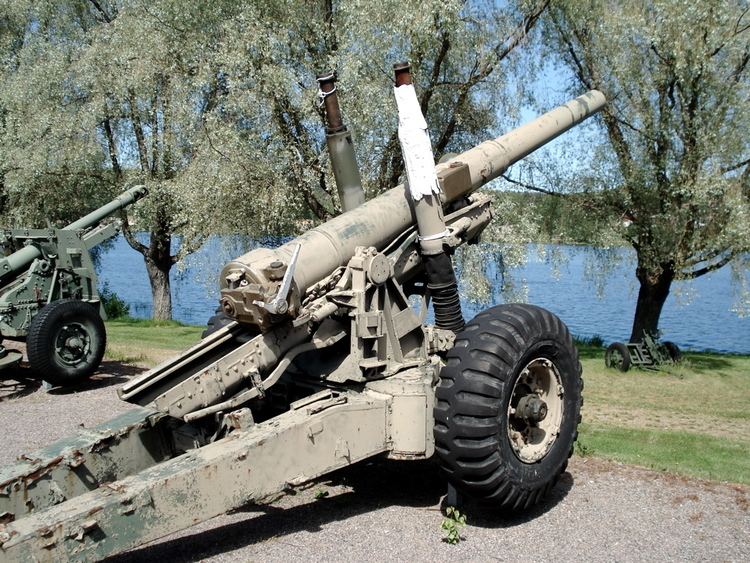Type Medium gun In service 1941-1980 (UK) | Place of origin United Kingdom Produced 1941-1945 | |
 | ||
Used by United Kingdom
France
Poland
Australia
Canada
India
Portugal
Myanmar
Iraq
Malaysia
Namibia
Oman
Pakistan
South Africa
New Zealand (13) Wars World War II, Korean War, Yemen, Borneo Conflict, Angolan Civil War | ||
The BL 5.5 inch Gun was a British artillery gun introduced during the middle of the Second World War to equip medium batteries.
Contents
History
In January 1939 a specification was issued for a gun to replace the 6 inch 26 cwt howitzers in use with most medium batteries. The first units were equipped in UK in the summer of 1941 and in North Africa a year later, 20 guns equipped British and Free French batteries at El Alamein. Subsequently it also equipped Canadian, Australian, South African, Polish and Indian regiments, and after the war, it was also used by New Zealand. In the Second World War the normal organisation was a regiment of 16 guns organised into two batteries.
The 5.5 was retained in service after the war. It was used by the Royal Artillery on operations in Korea, South Arabia and Borneo. It was probably used by the Indian Army in wars against Pakistan, and was used by the Pakistan Army against India in the mountains of Kashmir during the Kargil War of 1999.
The South African Defence Force used it extensively in the early stages of the South African Border War, including Operation Savannah, calling it the G2. Approximately 72 are still held in reserve by the South African Army.
In British post-war service it also replaced the BL 4.5 inch Medium Field Gun. When 6-gun batteries were introduced in the late 1950s, medium regiments had 18 guns and the third battery in each field regiment was equipped with 5.5 inch guns instead of 25 pounder guns. It remained in UK service with Territorial Army regiments until 1980 and in Australian service until replaced by M198 in about 1984.
The UK replacement for 5.5 inch was the FH-70 155 mm towed howitzer, in service as L121. The last 5.5 rounds were fired in the UK in 1995.
In use, the 5.5 was generally towed by the AEC Matador artillery tractor. From the 1950s in British service, the 5.5 was typically towed by an AEC Militant Mk 1 6x6 truck and subsequently the FV 1103 Leyland Martian 6x6 Medium Artillery Tractor .
All 5.5 guns were manufactured in the UK.
Description
There were four marks of 5.5 inch ordnance although only 3 and, after World War II, 4 entered service, and the differences were only minor. There were two marks of carriage where the differences were greater use of welding and less of riveting. The carriages were identical to those used with Ordnance BL 4.5 inch Mark 2. No limber was ever used and the gun fired with its wheels in contact with the ground.
During World War II the PL Locks and AC Slide Boxes, (a component separate to the gun attached to the bottom and face of the breech block using a rifle-calibre tube insert to initiate firing of the bagged charge) utilising 0.5 inch tubes were replaced by PK Locks and Y Slide Boxes using 0.303 inch tubes.
It used one man laying and had Probert pattern calibrating sights. The Dial Sight was initially the No 7 but was gradually replaced by the No 9. In the 1960s sights were converted from degrees, minutes and yards to mils and metres. There was no anti-tank telescope. Late in the war a sight adapter was introduced to permit upper register (high angle) fire when the wheels were raised significantly above the level of the spades.
The normal gun detachment was 10 men.
Ammunition
Initially 5.5 inch fired a 100 lb shell (6/12 crh) and 4 charges in two cartridges giving a maximum range table MV of 1675 feet per second and 16,200 yards.
In 1944 an 82 lb shell (8/16 crh) was introduced along with Charge Super giving a maximum range table MV of 1950 feet per second and 18,100 yards. The lighter shell contained 1.5 lbs more HE and gradually replaced the heavier shell.
In addition to HE there were several chemical (90 – 98 lbs) and coloured smoke shells (100 lb only), coloured flare was developed. After the war only HE was used.
The normal HE fuze was No 117. In late 1944 a VT fuze T100 became available.
Variants
No variants entered service although the UK developed two self-propelled versions to prototype stage. The first in 1945 used the Crusader gun tractor (developed from the Crusader tank to tow 17 pounder anti-tank guns). It was a turretless design with no casemate. The second, FV3805, in the 1950s used a Centurion tank carriage, the gun being in a barbette mounting in a fully enclosed casemate.
Australia
Fort Lytton Military Museum, Brisbane.
